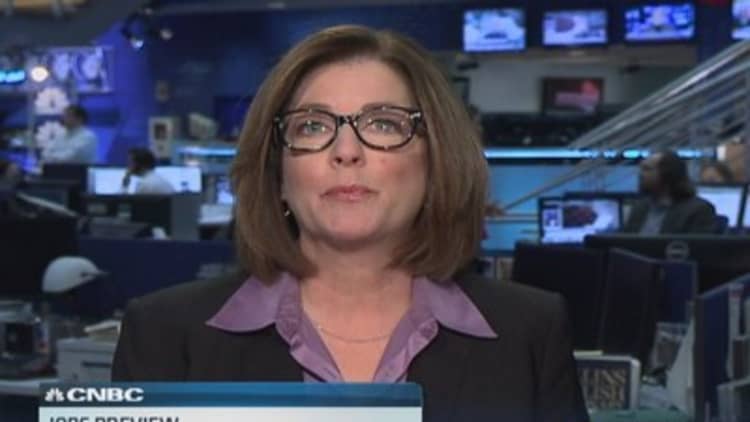
After hunkering down in the cold winter months, employers most likely increased hiring in March, but maybe not as much as some traders would like to see.
The consensus forecast of economists is 200,000 nonfarm payrolls and an unemployment rate of 6.6 percent, compared with the 175,000 jobs added in February and an unemployment rate of 6.7 percent, according to Thomson Reuters.
But there are whispers of 220,000 to 240,000, and some traders believe it could be even higher.
"A lot of the rally in the last couple of days has been people getting ahead of this number," said Dan Greenhaus, chief global strategist at BTIG. He expects to see 225,000 jobs added, and he said it's a given stocks will sell off if the number misses the consensus.
"Ultimately what matters is not whether it's 250,000 or 200,000. It's whether the number corroborates that the weakness earlier this year was weather related," Greenhaus said.
Diane Swonk, chief economist at Mesirow Financial, expects that 240,000 payrolls were added in March. Swonk said that the "hibernation" behavior of consumers in winter should have switched to a "migration" as more consumers started going out and traveling again, to resorts and elsewhere.
Read More
"I think we could see an upside surprise with some of the migration starting to help out. We still will have some weather vulnerability," she said. "The week of the survey was another bad week. The vulnerability is to construction jobs."
A fierce winter that brought record cold, heavy snowfalls and ice storms well into March could still have some negative effect on hiring. But for some traders, they are hopeful that perhaps there was enough pent-up demand to cause a strong bounce back, much the same as was seen in March's strong auto sales.
Vehicle sales came in at an annualized selling rate of 16.4 million in March, much better than the 15.8 million expected by economists.

Chris Rupkey, chief financial economist at Bank of Tokyo-Mitsubishi UFJ, said some market players may be expecting too much.
"Everyone's hopeful that the warmer weather is going to mean that we're going to see an improvement in hiring and the profile in hiring," he said. "The thing that worries me is we've been led down the primrose path many times, and it's ended badly. The best I can say is I'm keeping my fingers crossed."
Rupkey said the jobless claims data have been encouraging despite a slight increase in the past week to 326,000. "The labor market is still healing. If it's a bad outcome, it's probably going to be bedlam if that number is not so good. I hope 200,000 is enough," he said. "I'm afraid we've been stoking the fires a little too much."
Treasurys were trading higher Thursday, with yields moving lower after jobless claims were slightly higher than expected, and data that showed the trade deficit unexpectedly widening. The trade number was a particular concern since it will impact GDP. JPMorgan economists said the number puts their forecast of 1.5 percent first-quarter growth at risk.
Rupkey said the bond market is expecting rates will rise after the jobs report, when it is released at 8:30 a.m. ET on Friday. "We've been locked in this range of 10 years for two months, so when we break out of that range it's a big deal," he said, noting the range of 2.6 to 2.8 percent. "We're going into that number at 2.8, expecting to push higher."
He said in a note that the whisper numbers were 220,000 to 240,000, but some traders say they are hearing numbers higher than 250,000. "I think the chance of a surge in yields is higher than a chance for a collapse in yields. ... The market really wants to sell off here in terms of price. The two-year and five-year yields are telling you people are preparing for higher yields," Rupkey said.
The employment report is one of many data points watched by the Fed, but it is viewed as a critical component in its policy decisions. Therefore, the jobs number will also help shape market expectations for the Fed's wind down of its quantitative easing program and ultimate move to raise rates, now expected in 2015.
Ian Lyngen, senior Treasury strategist at CRT Capital, said the market was not trading Thursday as if it expected a higher number, and labor anecdotes were more negative than positive for March. "Those are skewed negative, and the market's rallying. None of these really suggest there's a screaming upward bias for the number but there seems to be these spring animal spirits," Lyngen said.



